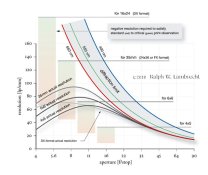T42
Member
Hello Forum.
Is diffraction categorically a problem at f/22, no matter what the actual, physical diameter of the open aperture is? If I am using a 200mm telephoto at f/22, is diffraction any more or less serious an issue than if I were using a 50mm lens, or a 24mm lens at f/22?
Until now, I have been of the opinion that diffraction becomes an issue when the physical diameter of the aperture opening becomes small enough to be within the range of a few wavelengths of the light passing through it. One source I remember from the past said that somewhere around 1mm aperture and smaller, diffraction is going to be a problem.
Lately I have read that one should not shoot at f/16 if he does not want diffraction as an issue. And I have also seen some things that suggest that diffraction has nothing to do with physical aperture size, but that it does have to do with f number and wavelength.
Now, I would have guessed that f/16 would be big trouble with those new micro-format digi-cameras which have a 12mm normal lens or some such. That would be an aperture on the order of 0.75mm. In fact, I'm thinking that such cameras do not even have f/16 because of that. On the other hand, a 200mm lens at f16 would have an approximate/effective aperture diameter of 12.5mm, well over that 1mm threshold that I remember from the past.
That's confusing to me how that f/16 or f/22 is categorically asking for diffraction issues, regardless of focal length. Can anyone here help me sort out this misunderstanding I seem to have?
Thanks a million for reading this.

Is diffraction categorically a problem at f/22, no matter what the actual, physical diameter of the open aperture is? If I am using a 200mm telephoto at f/22, is diffraction any more or less serious an issue than if I were using a 50mm lens, or a 24mm lens at f/22?
Until now, I have been of the opinion that diffraction becomes an issue when the physical diameter of the aperture opening becomes small enough to be within the range of a few wavelengths of the light passing through it. One source I remember from the past said that somewhere around 1mm aperture and smaller, diffraction is going to be a problem.
Lately I have read that one should not shoot at f/16 if he does not want diffraction as an issue. And I have also seen some things that suggest that diffraction has nothing to do with physical aperture size, but that it does have to do with f number and wavelength.
Now, I would have guessed that f/16 would be big trouble with those new micro-format digi-cameras which have a 12mm normal lens or some such. That would be an aperture on the order of 0.75mm. In fact, I'm thinking that such cameras do not even have f/16 because of that. On the other hand, a 200mm lens at f16 would have an approximate/effective aperture diameter of 12.5mm, well over that 1mm threshold that I remember from the past.
That's confusing to me how that f/16 or f/22 is categorically asking for diffraction issues, regardless of focal length. Can anyone here help me sort out this misunderstanding I seem to have?
Thanks a million for reading this.




